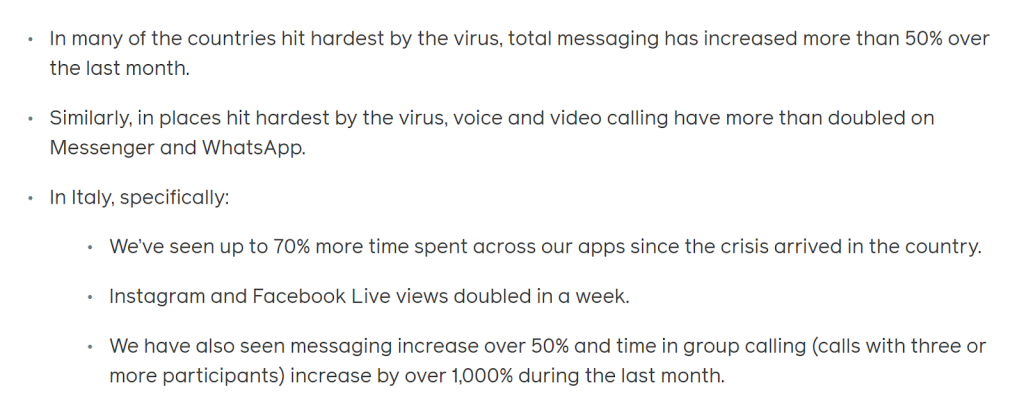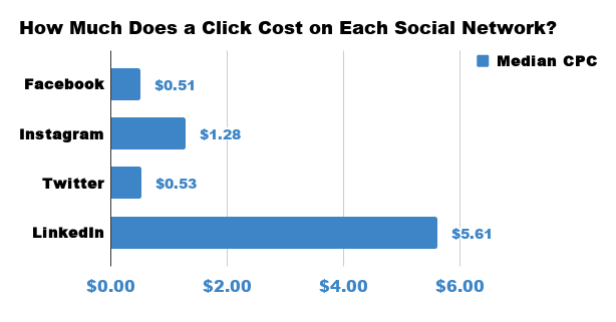Is Facebook advertising a hidden gem for low cost B2B marketing and engagement during the pandemic?
How do we start talking about this in a time of public health crisis affecting several lives and businesses going under with people locked down in their homes and being anxious? An event like this happens once in a lifetime after all. The COVID-19 pandemic has changed how we work. Many of us are working from home right now. Us talking about the human aspect and the human cost of this pandemic will be moot as this is not an area of our expertise. What we can talk about is the business aspect and how it affects us as marketers.
In late February and early March, when things first started getting out of hand, businesses started to worry. The equity market crashed around the world making way for the bear market. With employees not able to work, most parts of the economy that relied on physical presence had to be halted. Digital businesses like ours (and possibly yours and your customer’s) have moved to ‘work from home’ strategy. With customer acquisition getting halted, businesses have started doing budget cuts all over to survive. When it came to SAAS, they started pausing subscriptions and certainly not starting new ones. The signs of an oncoming recession became obvious. This started a vicious cycle that has been best explained by Rand Fishkin in this blog post.

source: https://moz.com/blog/marketing-in-times-of-uncertainty
Fast forward to today…
It has only been 45 days and we are still in the middle of the crisis but these 45 days have felt like eternity. People have spent the last 45 days in high uncertainty and the uncertainty still exists although many people have started to settle down. That’s what we humans do, we get used to it. In the US, the Fed is pumping a good amount of money to save the economy and this has brought some recovery to the market. Although, it can’t be said that the volatile phase is over. The next crash can happen at any time and it won’t be the first time where the market recovered partially only to crash harder. Even after the outbreak is over, the consequences will be visible for a while. Businesses are going to struggle for a good amount of time. Especially the small businesses. Even blue chip companies are at risks of failure without government handouts. Well, that’s a different topic of discussion. The point is that people are starting to settle down. Unless something crazy happens, it can be believed that we have crossed the initial panic stage.
Where are your customers now? What are they doing?
If your customers are digital businesses, they are probably working from home right now. Even if they aren’t working from home, they are still online. But, they are certainly not buying as much as their companies are trying to cut costs. Here’s a chart from Neil Patel’s blog.

Source: https://neilpatel.com/blog/coronavirus/
Some of your potential customers are also distracted and facing productivity issues as they tackle the pandemic and the new work environment. As people are isolated, they are spending time on social media platforms to stay in touch with the rest of the world and their families and friends. Facebook is seeing massive traffic spikes due to this. Although the maximum spike is caused due to messages and video calls, people are also spending more time engaging on the platform. According to them, 70% more time is being spent across their platforms. Here’s a screenshot from their application:

What does it mean for you as a marketer?
Before we get into this, we have to repeat what industry experts are saying: Show empathy towards your customers and do not try to exploit the situation.
In a survey conducted by Avionos.com in 2019, they asked B2B buyers what they would expect from businesses if a recession hit in 2020. This now ends up being a terrible coincidence but it brought an interesting answer: Most buyers ended up voting for better resources that would provide them valuable information and also help them make their purchase decisions. While it is understandable that their stand can change while shifting to a real world scenario from a hypothetical question, it provides a strong ground work on what we are discussing today. To sum up:
- Your customers are probably spending decent amount of time on Facebook
- B2B buyers say that they would like better resources if a recession were to happen.
- An opportunity has opened up for you to have meaningful engagement with your prospects and customers
Leveraging Facebook for B2B during the crisis
The Problem
Facebook for B2B has always been a tricky game as the platform pioneers for B2C and doesn’t generally offer the data B2B businesses need. Creating B2B targeting is a difficult job with Facebook having limited business information. There are effectively four main problems:
- Proper B2B targeting is not possible which results in a lot of unqualified leads and visitors.
- B2B targeting on LinkedIn is miles better but LinkedIn ads cost 10 times higher (according to a study by Instapage). This will affect your ROI.

Source: https://instapage.com/blog/linkedin-ads-vs-facebook-ads
- More people spend time on Facebook and its subsidiary companies (like Instagram) than they do on LinkedIn. This has now amplified because of the pandemic.
- Facebook can be used to engage with leads and existing customers with valuable content and information. But, due to the lack of B2B data provided by Facebook, grouping lead or customers based on their profile is a hard job. As such, businesses are not able to serve tailored content.
The Solution
Salespanel tracks all of your visitors, leads and customers in real-time and enriches them with B2B information. It also helps you segment or qualify visitors with company and behavior information and also use CRM data and user profile data in addition to that for leads/customers. This data is sent to Facebook which effectively helps you accomplish these things:
- Run retargeting ads to only qualified visitors from your website.
- Create lookalike audiences of your best leads and customers.
- Only target visitors/leads who have a desirable buyer profile or perform desired set of actions.
- Personalize served content based on customer profile and behavioral patterns.
- Optimize bidding and dynamically allot value based on deal size, win probability, etc.
Here are some use case ideas:
- Segment based on company size and industry to serve business relevant posts.
- Sync lead score value or deal value to conversion tracking for bidding optimizations.
- Qualify leads based on intent and ICP and serve ads to only qualified leads
- Segment leads based on interests and serve them personalized ads based on products/use cases/solutions/services they are interested in.
- Serve nurturing content based on deal stage. Your ads will dynamically serve content based on where your leads are on the buying cycle.
If you were running ads on Facebook before the pandemic, it might be a good time to re-evaluate strategy and double down on targeted engagement as your prospects and clients are now on Facebook more than ever. Again, pointing to Rand Fishkin’s suggestions, the time now is to monitor your marketing channels and measure ROI instead of taking a scalpel and cutting off everything.
Facebook is going to be a strong B2B channel during the pandemic and will continue to be so after the economic situation is over. If you need help setting up B2B advertising, please get in touch with us.
Sell more, understand your customers’ journey for free!
Sales and Marketing teams spend millions of dollars to bring visitors to your website. But do you track your customer’s journey? Do you know who buys and why?
Around 8% of your website traffic will sign up on your lead forms. What happens to the other 92% of your traffic? Can you identify your visiting accounts? Can you engage and retarget your qualified visitors even if they are not identified?


